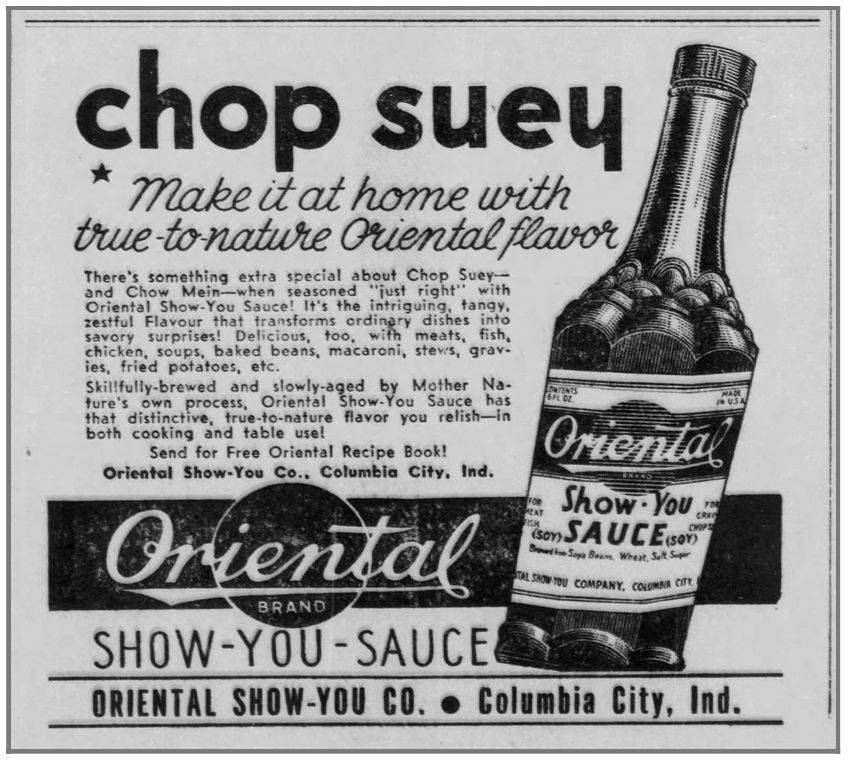
Purchase Tickets
The Show-You Sauce of Columbia City
April 10, 2020

Columbia City, Indiana is in the northeast part of the state in Whitley County, just west of the city of Fort Wayne. At a time when the Asian population would be heavily concentrated on either U.S. coasts and select major cities, who would have thought one of the nation’s few soy sauce manufacturers would be located in this small Indiana city? Centrally located between the major cities of Chicago and Detroit, this strategically would have made some sense. But why in Indiana?
Indiana’s own Shinzo Ohki would be one of the few producers of soy sauce in the United States with his company; Oriental Show-You Company. Shinzo Ohki was born south of Tokyo in the seaside town of Kamakura, Kanagawa prefecture, Japan in 1883 or 1884; public records vary on the exact year. He first appears in a list of 1907 graduates of Columbia City High School. Later in December 1907 and in January 1908 he is noted in newspapers giving stereopticon lectures of his 90-day tour of Japan, complete with 150 “magnificent dissolving views.” How he made his way to Indiana is a bit of a mystery. A 1939 column; “The Daily Grist” in the Wilmington News-Journal (Ohio) recalls a dinner party where Shinzo would tell his “100 or so” dinner guests his life story.
“Many years ago, a rich lady lived in the Hoosier town. She traveled quite a bit. Once when she returned from a trip around the world, she brought back a little Jap boy – not yet in his teens. His name was Shinze Ohki. The little fellow grew up and was educated in Columbia City. The benefactress died, but Shinze Ohki established himself.”
After his high school graduation at around the age of 23, Shinzo moved to Detroit, Michigan and later to Chicago, Illinois to work as an importer of Japanese goods. While in these cities he would start the Taka Tea Co and later the Oriental Show-You Company. “Show-You” is a cleaver play on word and marketing tactic; the Japanese word for soy sauce is Shoyu. Before returning to Indiana, he traveled back to Japan to learn how to make the fermented soy or mung bean sauce and would also meet and marry his wife, Taka Iwanaga. An October 1917 ship manifest indicates their joint return to the U.S. and in 1921 in Chicago, had their only child, a daughter named Grace. Shinzo would eventually return and settle in Columbia City, IN where his Show-You sauce and company would grow exponentially.

South Bend Tribune
In December of 1917 an advertisement for Moran’s Quality Delicatessen Saturday Specials in the Muncie Evening Press is when you see the first mention for the Show-You sauce. Outside of grocery store advertisements, it was regularly advertised and almost always with an offering of a free cookbook with purchase. Shinzo branched out to canned vegetables and chow mein. Local grocers like Kroger regularly advertised Shinzo’s goods in their weekly ads. Early advertisements in local newspaper would brand this sauce as “magic” and to help pep up anything from baked beans to last night’s leftovers.
During World War II, Japanese foreign nationals living in the United States were not permitted to become naturalized U.S. citizens, but required to register for the draft. In the era of the Japanese Internment camps, Shinzo would be omitted from having to self-report. First, because he lived outside of the militarized exclusion zone and local residents took up a letter writing campaign to vouch for his good standing and value to the community. I imagine he employed much of the city’s residents. After laws were changed he became a naturalized U.S. Citizen in 1954 at the age of 70 or 71.

Angola Herald
Their daughter Grace who grew up in Columbia City, Indiana and seemingly did not take over the family business. After high school graduation she attended The College of Wooster in Ohio and later moved to back Chicago, Illinois. She would later get married in 1953 and start a family in suburban Chicago. In the 1960s or 70s she, with her husband and children would leave the Midwest for California. Shinzo and Taka would continue to be active in their local Presbyterian Church and community, with Shinzo providing community meals and cooking demonstrations with his products. In 1960, he was involved with a highly publicized effort of helping repatriate Japanese Samurai swords. His wife, Taka, would pass away in 1963 with Shinzo following her in 1967. His company would later be sold to Beatrice Foods. From what I was able to research, Beatrice Foods was bought by ConAgra foods, which also owns La Choy. La Choy also has long standing roots in producing soy sauce, but not as long as Show-You.
Every time I see a bottle of soy sauce, a grocery aisle staple, I can’t help but think of and be grateful to Shinzo for his contribution to Indiana’s culinary past.








